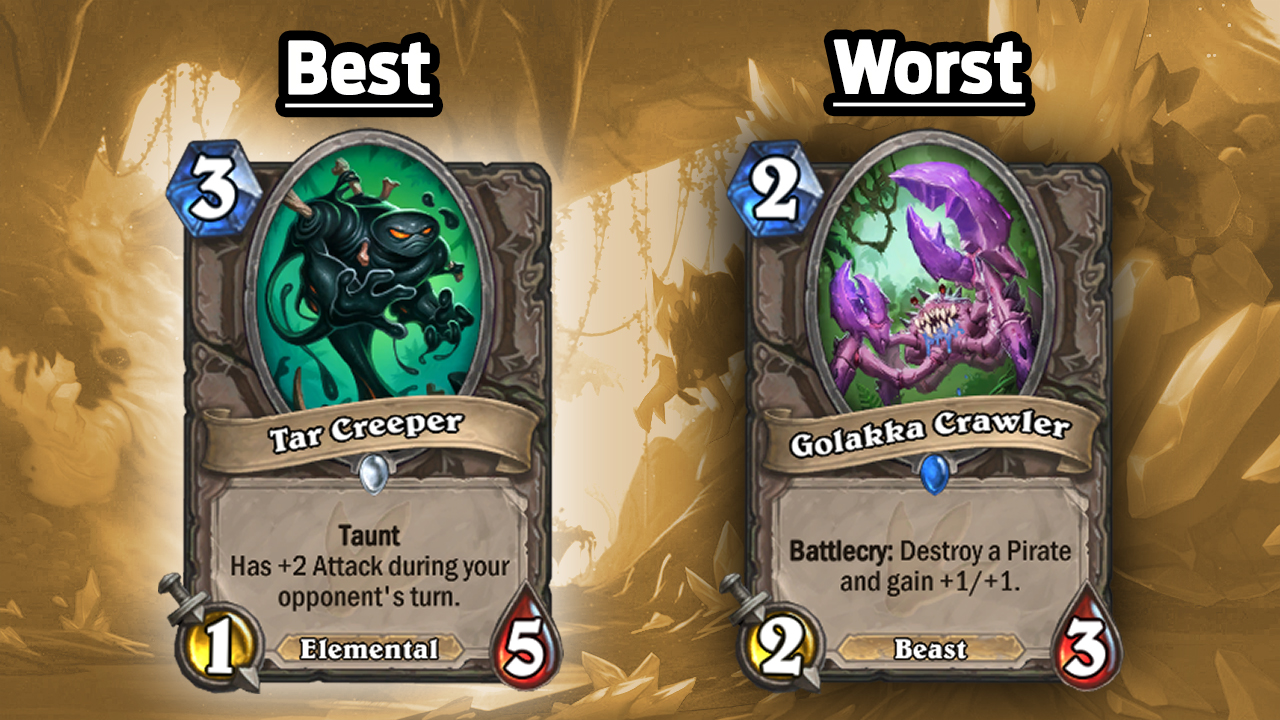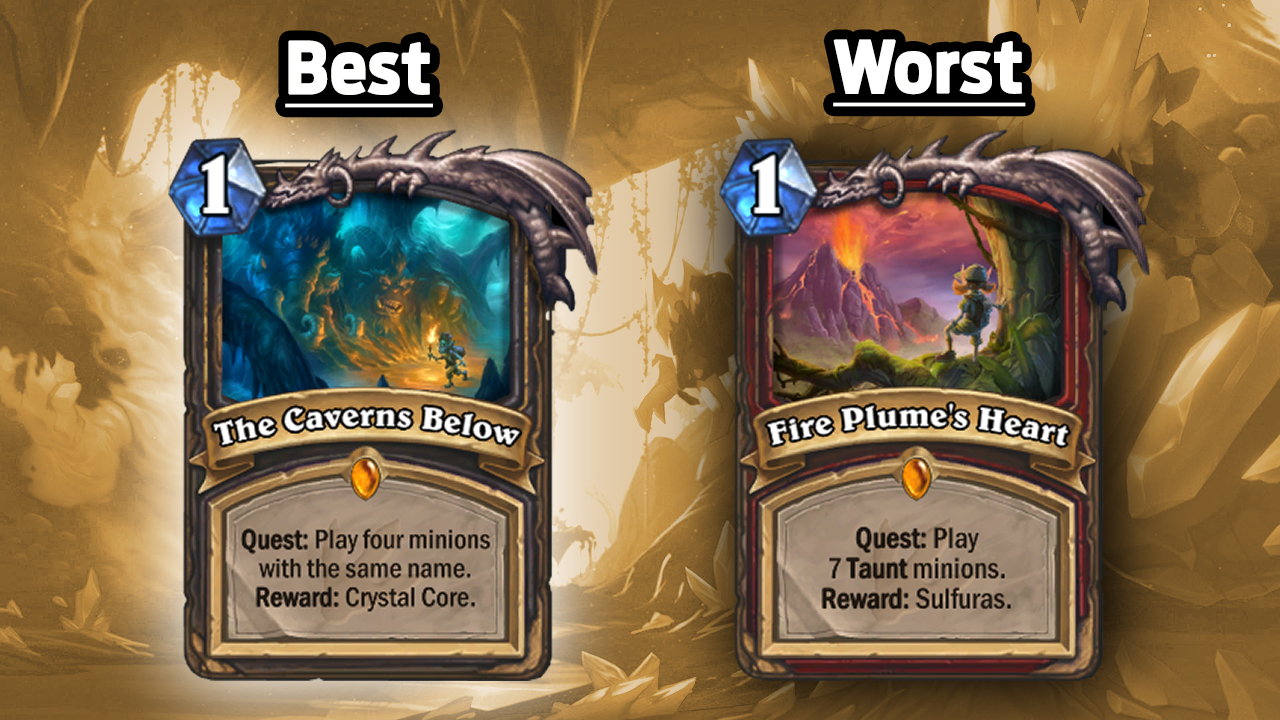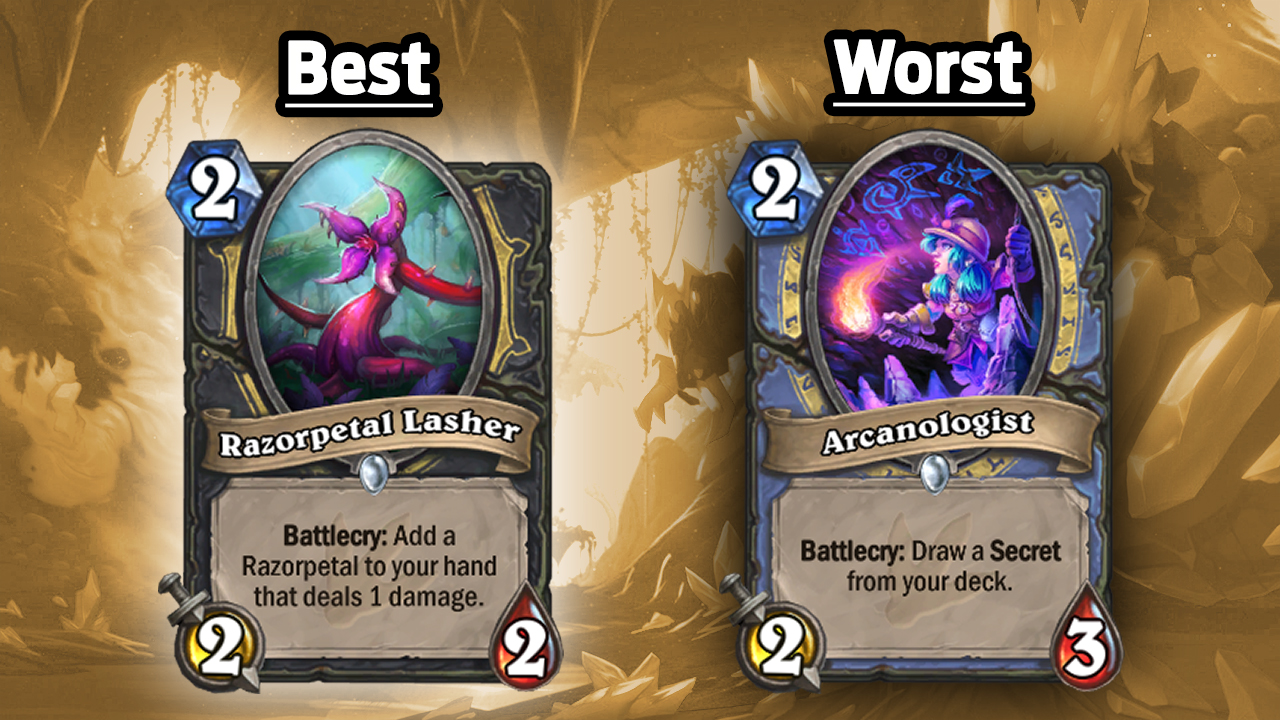Revisiting the best and worst of Journey to Un’Goro’s card design
From class flavor to Quest failures, what can be learned from the hits and misses of Hearthstone’s latest expansion.

While it’s true that the latest Standard rotation did a lot to freshen up the Hearthstone meta game, the quality of the Journey to Un’goro expansion also played a large part. The card design in the set was generally excellent, and eight of the nine classes are currently playable and represented on the competitive ladder with decent win rates. No one card, deck, class, or strategy feels particularly oppressive, which if you’ve spent any time in the Hearthstone scene feels… unusual.
That said, excellent is not the same as perfect. With the meta now stabilized, it’s useful to look back at the design hits and misses from the set with an eye towards how the game might improve in the future. With that in mind, I’ve picked the best and worst examples of Un’Goro cards according to five key categories. Starting with...
1. Defensive Cards

Tar Creeper is everything a defensive card should be: it functions as a powerful, neutral defensive option with much more limited applications as an offensive tool. While it’s a solid anti-aggro pick (some aggressive decks even include it to fight other aggressive decks), it’s by no means powerful to the point of being an auto-include in almost every deck the way a card like Sludge Belcher was. Tar Creeper has an interesting effect, fills its role nicely, but hasn’t saturated the meta.
Golakka Crawler is very effective at combating Pirate decks or, more specifically, decks playing Patches—and that’s exactly the problem. This card only sees play (and was only made, I think) because of what a meta-warping disaster Patches still is, and the design of Crawler strikes me as a way of treating the symptoms rather than the cause. I dislike the idea of printing a card that was a mistake, only to then print another card to address that mistake.
Suggestion for future sets: Fewer crab-style tech cards, more nerfs to exceptionally problematic designs.
2. Early-game minions

Fire Fly is a fantastic example of how to make a one-drop that almost anyone can enjoy. Firefly can be used in aggressive or defensive decks, has synergy with buff effects, doesn’t die to hero powers, but won’t snowball the game either. It even manages to pack elemental synergy for that added Un’Goro flavor and has further synergy with existing mechanics, like Combo, thanks to generating the addition 1-drop.
My weak design pick is Vicious Fledgling, the scourge of Arena mode since Un’Goro launched. What I find unpleasant about the pink flappy bird is not the power level (at least in constructed), but its ability to simply snowball out of control if unchecked. Early game cards that can singlehandedly win the game are often frustrating. My real issue with the card is actually only the Windfury option, as that’s the adapt which accelerates the blowout potential to scary levels.
Keep up to date with the most important stories and the best deals, as picked by the PC Gamer team.
Suggestion for future sets: Let decks snowball the game, rather than individual cards—especially when they’re low cost.
3. Quests as vehicles for class flavor

There’s little question that many players have deep connections to particular classes. As such, designing cards that fit the themes of those classes is a recipe for success. If you’re playing a Warrior, you want to feel like a Warrior. In that regard, The Caverns Below, Lakkari Sacrifice, The Last Kaleidosaur, and Open the Waygate all made for a great fit. I should note that I’m not talking about the power level of these Quests or their rewards, but rather how their design suits the unique flavor of the class they’re found in. In each case, completing the Quest requires leveraging specific effects inherent to each class, which means they feel like they belong.
On the other hand, there are several quests that failed at this goal. Fire Plume’s Heart, The Marsh Queen, Unite the Murlocs, Awaken the Makers and to a lesser extent Jungle Giants, are all variations on the same theme of, “play X number of this type of minions,” none of which help make the quests feel unique. I’m not saying that their design is lacking just because they’re simple, but rather because they don’t feel very flavorful. The Priest quest could have involved playing/taking control of cards from your opponent’s deck. The Shaman quest could have involved playing cards that draw on the power of all the elements. The Hunter quest could have involved beasts. The Warrior quest could have focused on armor or weapons. The Druid quest would have been more suited to taunts, though playing large minions at least fits the class.
Suggestion for future sets: Strive to maintain class identity, especially at legendary rarity as these should be class/deck-defining cards.
4. Card advantage tools

Admittedly, this is quite similar to the discussion about Quests, but let’s talk about the cards designed to fit the theme of their class. Razorpetal Lasher does so much that a Rogue deck wants, but its power level is not egregious. The 2/2 body is slightly-below curve, but its effect synergizes with Rogue’s Combo cards. It can provide a little extra tempo push worth of damage, but won’t snowball the game on its own. It also works well in the classic Miracle archetype, plays nicely with the other new ‘plant’ cards (‘Sherazin, Corpseflower’ and ‘Vilespine Slayer’), and fits the overall theme of the set. Also, because your opponent knows what card you received, both players can plan accordingly.
On the negative end we have Arcanologist, Mage’s ubiquitous new 2-drop. This card certainly fits with Mage’s flavor (secrets) and synergizes with the classic Freeze and Temp deck archetypes. The problem is that it’s just a hair too powerful, and that makes all the difference in terms of frustration. Compare Arcanologist to Razorpetal Lasher and the difference in power become stark. My intuition tells me Arcanologist would still see play and be good as a 2/2. That extra stat point makes all the difference in terms of balance, however, because Arcanologist is an early-game minion. Not to mention that this card was released immediately after Ice Lance was moved to Wild to try and relegate Freeze Mage to that format, which feels like a remarkable design oversight.
Suggestion for future sets: Consistent card draw should not be priced at 0 mana, ever.
5. Discovering additional cards

When the Discover mechanic was first released, it was met with widespread praise. Lately, opinion seems to be shifting due to how dominant the effect has become. Nevertheless, Shadow Visions stands head and shoulders above the rest as an example of the mechanic done right. I said at the start that perfection is a design ideal, but Shadow Visions comes very close. The card introduces a new effect to the game in the form of Hearthstone’s first flexible tutor (ideal for finding the right answers or combo pieces; not just minions), it’s fairly costed, rewards good deckbuilding, adds consistency to several Priest archetypes, fits the class, and provides your opponent with information if they’re savvy enough. It even has synergy with newly-released cards and makes previously bad combos like Inner Fire and Divine Spirit competitively playable, but not in any game-breaking way.
And then there’s Primordial Glyph. When I saw the card, my first thought was, “Well, that’s going to get jammed into every single Mage deck until it rotates.” So far I see no sign of that being wrong. Primordial Glyph is powerful and flexible, but in an unpredictable way. Because of the discount on the discovered card, it removes any chance your opponent can play around outcomes while simultaneously not encouraging any particular type of deckbuilding. (It seems to be designed for the Mage quest deck, but was too good not to be played everywhere). Again, as with Arcanologist, the flexibility of this card is effectively costed at zero mana, unlike other Discover spells, like Raven Idol or Hallucination, each of which costs 1.
Glyph is responsible for many frustrating moments, like turn five Flamestrikes, Discovering a card that generates more random cards (even getting a free reroll by discovering another Glyph), or finding a third (or fourth) Ice Block. It could be made more interesting by imposing additional constraints (only discovering spells that did not start in your deck, like an inverted Shadow Visions), or simply by dropping the discount after the turn it was cast to allow for additional counter play (even if it would likely be bad at that point).
Suggestion for future sets: Discover effects should be relatively strictly constrained.
Final thoughts
Though some design features of Un’Goro could be improved upon, even many of the more troublesome decisions don’t seem to be having an appreciably negative impact on the game. While a balanced meta is not an excuse to rest on one’s achievements, it is always worth appreciating the success of the expansion to provide a more balanced assessment of the state of the game. With the announcement of the next new expansion likely just around the corner, I’m optimistic and excited for the future after Un’Goro, and I hope you are too.

